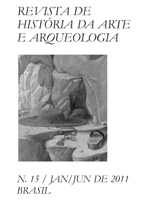Abstract
Dans la fresque représentant les Vertus, sur le mur sud de la Chambre de la Signature, au Vatican, Raphaël cite le Moïse de Michel-Ange. Pour découvrir le sens et les raisons qui ont motivé cette appropriation, il faut identifier les transformations que
le peintre a opérées par rapport à son modèle. Mais il faut également envisager la manière dont la citation du Moïse a été « greffée » au sein de la trame figurative, c’est à dire comprendre comment elle s’articule aux autres figures de la fresque.
References
ARASSE, Daniel. Léonard de Vinci. Le rythme du monde. Paris: Hazan, 1997.
ARGAN, Giulio Carlo e CONTARDI, Bruno. Michel-Ange architecte. Paris: Gallimard/Electa, 1990.
BATTISTI, Eugenio. “Di alcuni aspetti non veneti di Tiziano”, in Tiziano e Venezia. Convegno Internazionale di studi. (Veneza, 1976), Vicence: Neri Pozza, 1980.
BATTISTI, Eugenio.“Il Concetto d’imitazione nel Cinquecento italiano”.In: Rinascimento e Barocco. Turin: Einaudi, 1960.
BAYARD, Pierre. Le plagiat par anticipation. Paris: Éditions de Minuit, 2009.
BETTARINI, R.; BAROCCHI, Paola (org.). Le Vite de’piu eccellenti pittori, scultori, architettori nelle redazioni del 1550 e 1568. Florence: Sansoni, 1966-1997, testo IV.
COMPAGNON,Antoine. La seconde main ou le travail de la citation. Paris: Seuil, 1979.
CUZIN, Jean-Pierre. Raphaël vie et oeuvre. Paris: Bibliothèque des Arts, 1983, p. 164.
DE VECCHI, Pierluigi. Raphaël. Paris: Citadelles & Mazenod, 2002, p. 272.
DOREZ, Leon. La Canzone dele virtù e dele scienze di Bartolomeo di Bartoli da Bologna, Bergame:Istituto Italiano d’arti graphiche editore, 1904, folio 2 verso facsimile (não paginado).
EMILIANI, Andrea e SCOLARO, Michela. Rafaello. La Stanza della Segnatura. Milão: Electa, 2002.
GILBERT, Creighton E. “Some findings on early works of Titian”. The Art Bulletin, LXII, mar/1980.
GOFFEN, Rona. Renaissance Rivals. Michelangelo, Leonardo, Raphael, Titian. New Haven-Londres: Yale University Press, 2002.
HARTT, Frederick. History of Italian Renaissance. New York: Abrams, 1969.
JOANNIDES, Paul. “La chronologie du tombeau de Jules II. À propôs d’un dessin de Michel-Ange”. La Revue Du Louvre, 2, maio de 1991.
JOANNIDES, Paul.“On some borrowings and non-borrowings from central Italian and antique art in the Work of Titian c. 1515 c. 1550”. Paragone, 1990, n. 487 (setembro).
JOANNIDES, Paul. The Drawings of Raphael with a complete catalogue. Oxford: Phaïdon, 1983.
JOOST-GAUGIER, Christiane L. “Michelangelo’s Ignudi and the Sistine Chapel as a Symbol of Law and Justice”. In: Artibus et Historiae, 1996 (XVII), n. 34.
JOOST-GAUGIER, Christiane.“Sappho, Appolo, Neopythagorean theory and Numine afflatur in Raphael’s fresco of the Parnassus”. Gazette des Beaux-Arts, 1993, CXII (outubro).
KATZENELLENBOGEN, Adolf. Allegories of the Virtues and Vices in Medieval Art from early Christian Times to the Thirteenth Century. Londres: Warburg and Courtauld Institutes, 1939; Toronto: University of Toronto Press, 1989.
LAVIN, Irving. “Michelangelo, Mosè e Il ‘papa guerriero’.”Il Ritratto nell’Europa Del Cinquecento, atti Del convegno. Firenze, 7-8 de novembro de 2002.
MÂLE, Emile. L’art religieux à la fin du Moyen Âge en France (1908). Paris: Armand Colin, 1995.
MARIN, Louis. “De la citation. Notes à partir de quelques œuvres de Jasper Johns”. Artstudio, 1989, n. 12.
OBERHUBER, Konrad. Raphaël. Paris: Editions du Regard, 1999.
PANOFSKY, Erwin. Tomb Sculpture. Four lectures on its changing aspects from ancien Egypt to Bernini. New York: Abrams, 1992.
PLÍNIO. Histoire naturelle.Tradução de J. André. XVI, 3-4. Paris: Les Belles Lettres, 1962.
PON, Lisa. Raphael, Dürer and Marcantonio Raimondi. Copying and the Italian Renaissance Print. New Haven: Yale University Press, 2004.
ROSENTHAL, Earl E. “Michelangelo’s Moses da sotto in sù”. The Art Bulletin, XLVI, dezembro de 1964.
SHEARMAN, John. Raphael in early modern sources 1483-1602. New-Haven: Yale University Press, 2003.
SHERMAN, John. “Progetti non eseguiti per le Stanze di Raffaello”, in S/R Studi su Raffaello, Milão: Electa, 2007.
TAUTIL, Jean-Christian. “Prudence, Force et Tempérance dans le décor de la Chambre de la Signature”. Chroniques italiennes, n. 60 (4/1999).
TUVE, Rosamond. “Notes on the virtues and vices: 1: two fifteenth-century lines of dependence on thirteenth and twelfth centuries”. Journal of the Warburg and Courtauld Institutes, 26, 1963.
VALERIANO, Piero. Apud PANOFSKY, E. L’Œuvre d’art et ses significations. Essais sur les arts visuels. Paris: Gallimard, 1969.
VIRGÍLIO. “4ª écloga”, in Les Bucoliques. Tradução de Paul Valéry. Paris: Gallimard, 1956.
VOELKLE,William.“Morgan M. 359 and the origin of ‘the new iconography’ of the virtues in the fifteen century”.In: Album amicorum Kenneth C. Lindsay. Essays on Art and Litterature, sob a direção de Susan A. Stein e Georges D. McKee, Binghamton: State University of New York at Binghamton, 1990.
WILDE, J. “The Tomb of Julius II”, in Michelangelo. Six Lectures. Oxford: Clarendon Press, 1978.
WIND, Edgar. “Platonic Justice designed by Raphael”. Journal of the Warburg and Courtauld Institutes, 1937-1938, I.

This work is licensed under a Creative Commons Attribution 4.0 International License.
Copyright (c) 2021 Journal of Art History and Culture

